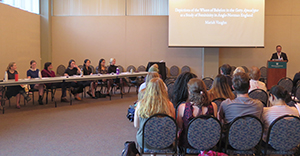Undergraduate Research in Art History
Required Research Courses
Research is the heart of a degree in art history. As an Art History major you will learn to do research in all your courses, but you will gain intense training during the three required core seminars. Theories & Methods of Art History (ARTH 333), will focus on research methods and interpretive approaches. The Curatorial Project (ARTH 331) will challenge you with thematic study through an innovative exhibition. During your senior year, the Senior Research Colloquium (ARTH 493), our capstone seminar, provides an opportunity to develop, discuss, and refine a research project in depth, culminating in an oral presentation at a public symposium to which family, friends, colleague, and the community are invited.
Independent Research in Art History
In addition to taking the required research courses, Art History majors may pursue independent, individualized research projects on topics of particular interest to you. Such projects can result in written research papers, public presentations, and/or publications.
Independent research in Art History frequently grows out of a term paper written for a regular course or seminar. In order to pursue independent research on a topic of special interest to you, contact a faculty mentor and ask if they will serve as your research advisor. Work with your research advisor to design a project.
There are several ways you can earn credit for independent research in Art History:
- Independent Study (ARTH 490, 1-3 credits) - An Independent Study course is a semester-long exploration of a topic agreed upon by the student and a faculty mentor. Normally, an Independent Study may be taken only once. Academic credit for independent study courses varies based on the extent of the project and the length of the final paper or other culminating outcome.
- Honors (ARTH 495-496, 6 credits) - To earn Honors as a major in Art History, you must complete an intensive, yearlong research project under the direction of a faculty mentor, resulting in an Honors Thesis. The Honors Thesis can expand on research already undertaken in a previous course, including an independent study course or a summer research project. Details...
- Internships (ARTH 389, 1-3 credits) - An internship provides practical, hands-on professional experience in applied art history, often in a museum, gallery, historic house, or commercial setting. Such experience can be valuable in helping you decide what future career and/or educational path to pursue. It also helps build a resume or dossier of employment testifying to your work experience and your network of colleagues and contacts in the field. Our students have interned at local, regional, and national museums, including the Muscarelle Museum of Art at William & Mary, the Art Museums of Colonial Williamsburg, the Virginia Museum of Fine Arts in Richmond, the Smithsonian American Art Museum in Washington, D.C., the Metropolitan Museum of Art in New York, and other institutions. Details...
Funding for research
Several William & Mary programs and centers offer Art & Art History majors the opportunity to obtain funding to conduct independent research. The Charles Center coordinates most W&M funding for undergraduate research, including Summer Research Grants, Honors Fellowship, and Semester Research Funding, as well as external scholarship programs. If your research will involve study abroad, the Reves Center may have funding that can help.















